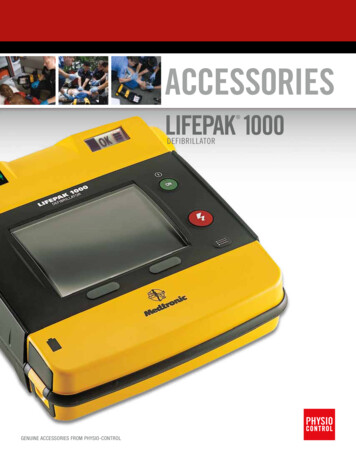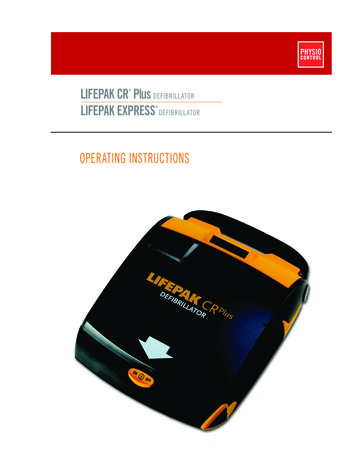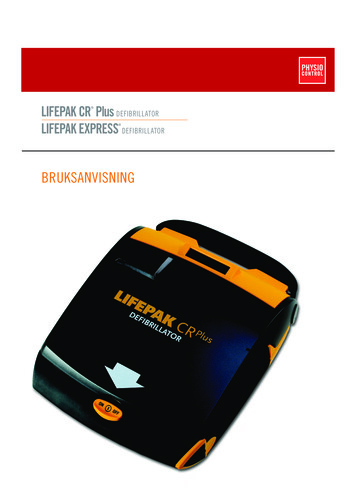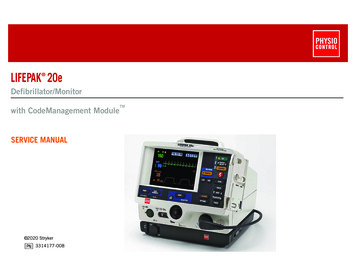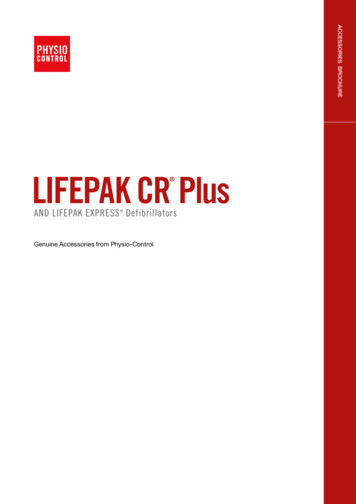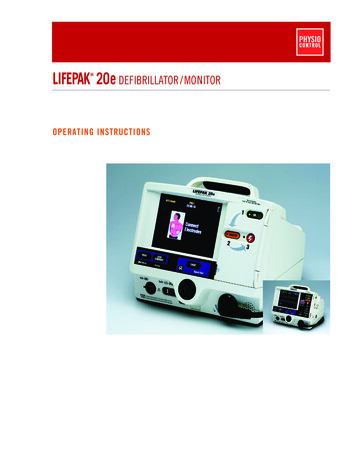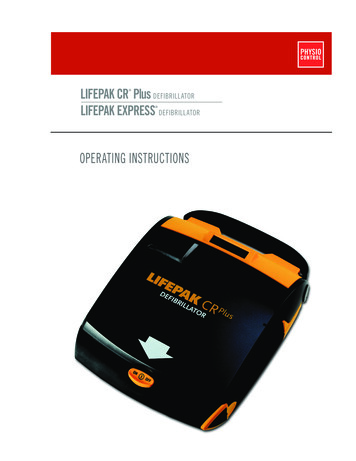
Transcription
LIFEPAK CR Plus DEFIBRILLATORLIFEPAK EXPRESS DEFIBRILLATOR OPERATING INSTRUCTIONS
LIFEPAK CR Plus DEFIBRILLATORLIFEPAK EXPRESS DEFIBRILLATOR OPERATING INSTRUCTIONS
Responsibility for InformationIt is the responsibility of our customers to ensure that the appropriate person(s) who may use this defibrillator haveaccess to the information in this manual, including general safety information provided in Section 1.!USA Rx OnlyDevice Tracking!USA The U.S. Food and Drug Administration requires defibrillator manufacturers and distributors to track thelocation of their defibrillators. If the device is located somewhere other than the shipping address or the device hasbeen sold, donated, lost, stolen, exported, destroyed, permanently retired from use, or if the device was not obtaineddirectly from Physio-Control, please do one of the following: register the device at http://www.physio-control.com, callthe device tracking coordinator at 1.800.426.4448, or use one of the postage-paid address change cards located inthe back of this manual to update this vital tracking information.Revision HistoryThese operating instructions describe the LIFEPAK CR Plus and LIFEPAK EXPRESS defibrillators with softwareVersion 3.0 or later.LIFEPAK, LIFEPAK CR, LIFEPAK EXPRESS, and QUIK-COMBO are registered trademarks of Physio-Control, Inc. ADAPTIV, CODE-STAT, CHARGE-PAK,QUIK-PAK, and Shock Advisory System are trademarks of Physio-Control, Inc. IrDA is a registered trademark of Infrared Data Association. Specifications aresubject to change without notice. 2018 Physio-Control, Inc.Publication Date: 01/20183201686-019
TABLE OF CONTENTS11 IntroductionAbout Automatic External Defibrillators . 1-2Indications for Use. 1-2Contraindications . 1-2Why the Need for Defibrillators . 1-2Terminology. 1-3Text Conventions . 1-4Safety Information . 1-4Safety Terms . 1-4General Warnings and Cautions . 1-5Symbols . 1-7About the LIFEPAK CR Plus and LIFEPAK EXPRESS Defibrillators . 1-10Capabilities and Features. 1-102 Getting StartedUnpacking and Inspecting Your LIFEPAK CR Plus or LIFEPAK EXPRESS Defibrillator . 2-2Where to Locate Your LIFEPAK CR Plus or LIFEPAK EXPRESS Defibrillator . 2-3Controls, Indicators, and Labels . 2-4Outside Controls, Indicators, and Labels . 2-4Inside Features. 2-53 Using the DefibrillatorWarnings and Cautions . 3-2Responding to a Sudden Cardiac Arrest Emergency . 3-2Basic Steps for Using the LIFEPAK CR Plus or LIFEPAK EXPRESS Defibrillator. 3-3What to Do After Emergency Medical Personnel Arrive. 3-5What to Do After Using Your Defibrillator . 3-5Voice Instructions and Tones . 3-5Troubleshooting . 3-6LIFEPAK CR Plus and LIFEPAK EXPRESS Defibrillator Operating Instructions 2018 Physio-Control, Inc.iii
4 Data StorageOverview of Data Storage . 4-2Data Stored by Your Defibrillator . 4-2Test and Service Data . 4-2Event and Test Log. 4-35 Caring for Your DefibrillatorMaintaining a State of Readiness . 5-2Replacing the CHARGE-PAK Battery Charger and the QUIK-PAK Electrode Packet . 5-2Replacing the CHARGE-PAK Battery Charger . 5-4Replacing the QUIK-PAK Electrode Packet. 5-6Storing Your Defibrillator . 5-7Cleaning Your Defibrillator . 5-7Obtaining Authorized Service . 5-8Recycling Information . 5-8Recycling Assistance . 5-8Preparation. 5-8Recycling of Disposable Electrodes . 5-8Packaging. 5-8Supplies, Accessories, and Training Tools . 5-9Warranty Information . 5-96 Defibrillator Operating SettingsOperating Settings and Setup Configuration . 6-2A SpecificationsClinical Summary: Monophasic vs. Biphasic Waveforms: In-Hospital-Trial .A-7Clinical Summary: Monophasic vs. Biphasic Waveforms: Out-of-Hospital Trial .A-8Clinical Summary: Pediatric Defibrillation - Animal Study .A-9Clinical Summary: Pediatric Defibrillation - Postmarket Surveillance Study .A-9Potential Adverse Effects .A-10B Shock Advisory SystemC User’s ChecklistD Electromagnetic Compatibility GuidanceIndexivLIFEPAK CR Plus and LIFEPAK EXPRESS Defibrillator Operating Instructions
1 IntroductionINTRODUCTION1This section provides background information about defibrillation and includes an overview ofLIFEPAK CR Plus and LIFEPAK EXPRESS defibrillator features.About Automatic External Defibrillatorspage 1-2Safety Information1-4Symbols1-6About the LIFEPAK CR Plus andLIFEPAK EXPRESS DefibrillatorsLIFEPAK CR Plus and LIFEPAK EXPRESS Defibrillator Operating Instructions 2018 Physio-Control, Inc.1-101-1
IntroductionABOUT AUTOMATIC EXTERNAL DEFIBRILLATORSThe LIFEPAK CR Plus and LIFEPAK EXPRESS defibrillators are automated external defibrillators(AEDs). For many years, defibrillators have been used only by medical professionals to treat victims insudden cardiac arrest (SCA). Today, the ability of defibrillators to save lives is so widely recognized thatpeople once trained to do only cardiopulmonary resuscitation (CPR) can now use defibrillators.After electrode pads are applied to the victim’s chest, the defibrillator analyzes the victim’s heart rhythm.If a shockable rhythm is detected, the defibrillator will either deliver an intense pulse of electricity(shock) to the heart muscle (fully automatic model) or direct the responder to deliver the shock(semiautomatic model). The defibrillator delivers shocks through the electrode pads on the victim’schest.When this pulse of electricity is delivered, it is called defibrillation. Defibrillation is recognized for treatinglife-threatening heart beat irregularities, such as ventricular fibrillation, that cause SCA.Indications for UseThe LIFEPAK CR Plus and LIFEPAK EXPRESS defibrillators are indicated for use on patients in cardiacarrest. The patient must be unresponsive (unconscious), not breathing normally, and showing no signsof circulation (for example, no pulse, no coughing, or no movement).The LIFEPAK CR Plus and LIFEPAK EXPRESS defibrillators are intended for use by personnel whohave been trained in their operation. Users should have received training in basic life support/AED,advanced life support or a physician-authorized emergency medical response training program.The defibrillators may be used with QUIK-PAKTM defibrillation pads only on adults and children who are8 years old or more, or who weigh more than 25 kg (55 lbs). The defibrillators may be used on childrenwho are less than 8 years old or weigh less than 25 kg (55 lbs) with Infant/Child Reduced EnergyDefibrillation Electrodes.The defibrillators may be used with the CHARGE-PAKTM battery charger.ContraindicationsDo not use the LIFEPAK CR Plus or LIFEPAK EXPRESS device when the victim is conscious andresponsive.Why the Need for DefibrillatorsThe American Heart Association estimates that, in the USA alone, at least 250,000 people die eachyear of cardiac arrest. Of these, about 10,000 people might have been saved had they receivedimmediate treatment from a defibrillator.Sudden cardiac arrest is usually caused by a malfunction in the heart’s electrical system. Calledventricular fibrillation, this critical condition prevents the heart from pumping blood throughout the body.Ventricular fibrillation can cause death within seconds.Defibrillation is a relatively simple procedure that involves placing electrode pads on a victim’s exposedchest and delivering an electrical shock to the heart. The externally-delivered shock often restores theheart’s electrical system to normal rhythm. Combined with CPR, defibrillation provides the mosteffective care for victims in cardiac arrest.1-2LIFEPAK CR Plus and LIFEPAK EXPRESS Defibrillator Operating Instructions
Introduction1 IntroductionTerminologyThe following terms appear in this manual.AEDAutomated External Defibrillator. A device that evaluates the victim’s heartrhythm and delivers an electrical shock to the heart if a shockable rhythm isdetected.Cardiac arrestThe termination of the heart’s pumping action resulting in the lack of aheartbeat or pulse and breathing.CPRCardiopulmonary resuscitation. This involves delivering rescue breathing andchest compressions to a victim in cardiac arrest.DefibrillationDelivery of an electrical shock to the heart for the purpose of reversingventricular fibrillation.ECGElectrocardiogram. A composite picture of what is occurring electrically in theheart.FibrillationChaotic activity of the heart’s electrical system. This condition can occur inthe atria or the ventricles. When it occurs in the ventricles, they quiver in arapid, chaotic manner, preventing them from pumping blood to the body.Heart attackA nonspecific term referring to the death of heart muscle resulting frominterruption of blood supply, often confused with cardiac arrest.ImpedanceResistance to the flow of electrical current through the body.JouleThe basic unit of energy delivered by a defibrillator.LEDLight emitting diodes.Myocardial infarctionThe specific term for what is usually meant by heart attack; death of heartmuscle resulting from an interruption of the blood supply to that area ofmyocardium.Nonshockable rhythmA heart rhythm that is detected by the defibrillator that does not need ashock, but may need CPR.VictimIn this manual, the person suffering from cardiac arrest.ResponderIn this manual, the person giving aid to a victim in cardiac arrest. Usedinterchangeably with user.Shockable rhythmA heart rhythm that is detected by the defibrillator as requiring a shock, forexample, ventricular fibrillation.UserIn this manual, the person giving aid to a victim in cardiac arrest. Usedinterchangeably with responder.Ventricular fibrillationA life-threatening chaotic heart rhythm.Ventricular tachycardia Rapid heart rhythm originating in the ventricle.LIFEPAK CR Plus and LIFEPAK EXPRESS Defibrillator Operating Instructions 2018 Physio-Control, Inc.1-3
IntroductionText ConventionsThroughout this manual, special text characters are used to indicate labels and voice instructions:Operating control labels: CAPITAL LETTERS such as ON/OFF and SHOCK.Voice instructions: ITALICIZED CAPITAL LETTERS such as STAND CLEAR.SAFETY INFORMATIONThis section provides important information to help you safely operate your defibrillator. Familiarizeyourself with all of the terms, warnings, and symbols presented in this section.Safety TermsYou may encounter the following terms in this manual and while using your defibrillator:DangerImmediate hazards that will result in serious personal injury or death to the user and/orthe victim.WarningHazards or unsafe practices that could result in serious personal injury or death to theuser and/or the victim.CautionHazards or unsafe practices that could result in minor personal injury to the user and/orthe victim, product damage, or property damage.1-4LIFEPAK CR Plus and LIFEPAK EXPRESS Defibrillator Operating Instructions
Introduction1 IntroductionGeneral Warnings and CautionsWARNINGS!Shock hazard.The defibrillator delivers up to 360 joules of electrical energy. Unless properly used as described in thismanual, this electrical energy may cause serious injury or death. Do not attempt to operate thisdefibrillator unless thoroughly familiar with this manual and the function of all controls, indicators,connectors, and accessories.Do not insert a finger or any object other than the CHARGE-PAK battery charger into the well of thedefibrillator.Shock or fire hazard.Do not immerse any portion of this defibrillator in water or other fluids. Avoid spilling any fluids on thedefibrillator or its accessories. Do not clean with ketones or other flammable agents. Do not autoclaveor sterilize this defibrillator or the accessories unless otherwise specified.Possible fire or explosion.Do not store this defibrillator in the presence of flammable gases or in direct contact with flammablematerial.Do not use this defibrillator in the presence of flammable gases or anesthetics. Use care whenoperating this defibrillator close to oxygen sources (such as bag-valve-mask device or ventilator tubing).Turn off gas source or move source away from patient during defibrillation.Possible device shutdown.When the attention symbolfirst appears on the readiness display, only a small number of shocksand monitoring time are available. Always keep a CHARGE-PAK battery charger in the defibrillator.Routinely check that the defibrillator is ready for use. Replace the CHARGE-PAK battery charger aftereach use of the defibrillator.Possible device failure.Do not modify this device.Possible electrical interference with device performance.Equipment operating in close proximity may emit strong electromagnetic or radio frequency interference(RFI) which could affect the performance of this device. RFI may result in improper device operation,distorted ECG, failure to detect a shockable rhythm, or cessation of pacing. Avoid operating the devicenear cauterizers, diathermy equipment, cellular phones, or other portable and mobile RFcommunications equipment. Maintain equipment separation of at least 1.2 m (4 ft) and do not rapidlykey EMS radios on and off. Contact a technical support representative if assistance is required.Possible electrical interference.Using cables, electrodes, or accessories not specified for use with this device may result in increasedemissions or decreased resistance to electromagnetic interference which could affect the performanceof this defibrillator or of equipment in close proximity. Use only parts and accessories specified in thismanual.Possible electrical interference.This device may cause electromagnetic interference (EMI) especially during charge and energytransfers. EMI may affect the performance of equipment operating in close proximity. If possible, verifythe effects of defibrillator discharge on other equipment prior to using the defibrillator in an emergencysituation.LIFEPAK CR Plus and LIFEPAK EXPRESS Defibrillator Operating Instructions 2018 Physio-Control, Inc.1-5
IntroductionWARNINGS!Possible improper device performance.Using other manufacturers’ cables or electrodes may cause the defibrillator to perform improperly andinvalidates the safety agency certification. Use only the parts and accessories specified in this manual.Using damaged or expired equipment or accessories may cause the defibrillator to perform improperlyand may injure the victim or the user.Safety risk and possible equipment damage.MR unsafe: keep the defibrillator away from magnetic resonance imaging (MRI) equipment.CAUTION!Possible equipment damage.This defibrillator may be damaged by mechanical or physical abuse, such as immersion in water ordropping the defibrillator. If the defibrillator has been abused, remove it from use and contact a qualifiedtechnician.1-6LIFEPAK CR Plus and LIFEPAK EXPRESS Defibrillator Operating Instructions
Introduction1 IntroductionSYMBOLSThe following symbols may appear in this manual and on the LIFEPAK CR Plus andLIFEPAK EXPRESS defibrillators. For more information about the readiness display symbols, refer toSection 2, "Getting Started".SymbolOKExplanationOK Indicator. On the readiness display—the defibrillator is ready for use.CHARGE-PAK battery charger indicator. On the readiness display—CHARGE-PAKbattery charger needs to be replaced.Attention. On the readiness display—the internal battery is low. Refer to page 2-4 formore information about the readiness display.Wrench indicator. On the readiness display—there is a condition that prevents orcould prevent normal defibrillator operation. Refer to page 5-8 for more information.On the CHARGE-PAK battery charger—consult the operating instructions. Refer topage 5-2 for more information about the CHARGE-PAK battery charger.On the back of the defibrillator—consult the operating instructions. Refer to page 1-5for more information about the warnings and cautions.On the electrode pads—consult the operating instructions. Refer to page 2-6 for moreinformation about electrode pads.Warning, high voltage.CHARGE-PAK battery charger.This end up.Fragile/breakable.Handle with care.Protect from water.Power On/Off button.Type BF patient connection.LIFEPAK CR Plus and LIFEPAK EXPRESS Defibrillator Operating Instructions 2018 Physio-Control, Inc.1-7
IntroductionSymbolExplanationDefibrillation protected, type BF patient connection.Not intended for use on children who are less than eight years of age or who weighless than 25 kg (55 lb).Infant/Child Reduced Energy Defibrillation Electrodes are not compatible withQUIK-COMBO defibrillation and therapy cables. To use Infant/Child Electrodes,connect Infant/Child Electrodes directly to the AED.Not intended for use on adults.Physio-Control electrodes are latex-free.Arrow indicates ON/OFF button location.Symbol denoting a defibrillator and identifies the shock button.LOTYYWW Lot code.Do not reuse—single use only.Use By date shown: yyyy-mm-dd.Refer to instructions for recycling procedure, page 5-8.Do not dispose of this product in the unsorted municipal waste stream. Dispose of thisproduct according to local regulations. See www.physio-control.com/recycling forinstructions on the proper disposal of this product.Symbol for China RoHS indicating the Environmentally Friendly Use Period (EFUP)denoting the number of years before any substance is likely to leak out into theenvironment.Mark of conformity according to the European Medical Device Directive 93/42/EEC.1-8LIFEPAK CR Plus and LIFEPAK EXPRESS Defibrillator Operating Instructions
Introduction1 IntroductionSymbolExplanationCanadian Standards Association certification for Canada and the United States.!USAFor USA audiences only.Atmospheric pressure limitation.Relative humidity range 5% to 95%.Do not store in direct sunlight.Recommended storage temperature: 15 to 35 C (59 to 95 F). Storage at extremetemperatures of -40 or 70 C (-40 or 158 F) is limited to seven days. If storage atthese temperatures exceeds one week, the electrode shelf-life will be reduced.YYYYDate of manufacture.CAUTION - FIRE HAZARDDo not disassemble, heat above 100 C (212 F), or incinerate batteryCAUTION - FIRE HAZARDDo not crush, puncture, or disassemble batteryFederal (U.S.) law restricts this device to sale by, or on the order of, a physician.orManufacturer’s Item Number (part number).Catalog number used for placing orders.Reorder number.Serial number.LIFEPAK CR Plus and LIFEPAK EXPRESS Defibrillator Operating Instructions 2018 Physio-Control, Inc.1-9
IntroductionABOUT THE LIFEPAK CR PLUS AND LIFEPAK EXPRESS DEFIBRILLATORSThe LIFEPAK CR Plus and LIFEPAK EXPRESS defibrillators are designed for indoor and outdoor use.The LIFEPAK CR Plus defibrillator has two models available—fully automatic and semiautomatic. TheLIFEPAK EXPRESS defibrillator is semiautomatic. After the electrode pads are applied, the fullyautomatic model evaluates the heart rhythm and, if a shockable rhythm is detected, delivers a shockwithout any responder assistance. The semiautomatic models evaluate the heart rhythm but require theresponder to press the shock button if a shockable rhythm is detected. All models have voiceinstructions that guide the responder through the defibrillation process.Capabilities and FeaturesThe following paragraphs introduce specific features found in the defibrillators.AccessoriesThe defibrillator arrives with an installed CHARGE-PAK battery charger, one preconnected QUIK-PAKelectrode packet, and the operating instructions. Refer to Section 5 for other accessories.Automated OperationVoice instructions guide the responder through the defibrillation process.The fully automatic defibrillator requires no operator interaction beyond placing the electrode pads onthe victim. If the defibrillator detects a shockable rhythm, it warns the responder prior to delivering anyshock, and then delivers a shock without operator interaction.The semiautomatic defibrillator has a highly visible shock button that the responder must press whenthe defibrillator issues a shock voice instruction.Automatic Self-TestsThe defibrillator tests itself each week and every time you turn it on. In addition, every month, thedefibrillator performs a more extensive self-test. This self-test checks the defibrillator’s circuitry to verifythat it is ready for use.ClearVoice TechnologyClearVoice technology was created specifically for portable medical devices. This technologyincorporates how the human ear interprets audio prompts and instructions within real world cardiacarrest response scenes such as shopping malls, on the freeway, or in an emergency room. ClearVoicetechnology minimizes distortion and enhances speech intelligibility so the user can clearly understandaudio and instructional prompts in a chaotic and stressful environment.Customized SetupThe defibrillator is shipped ready to use with the preprogrammed ADAPTIV biphasic escalatingenergy protocol and other operating settings. The operating settings are configured in accordance withcustomer order. Refer to Section 6, "Defibrillator Operating Settings".Data ManagementThe defibrillator digitally stores data when it is turned on and the electrode pads are successfullyapplied to the victim. The stored data includes date and time, ECG data, and the number of shocks. Thedefibrillator also stores the results of the automatic self-tests.Stored data can be transferred to a PC by means of a serial infrared link, the IrDA port. A data transferand management program running on the PC transfers event and test data from the defibrillator.1-10LIFEPAK CR Plus and LIFEPAK EXPRESS Defibrillator Operating Instructions
Introduction1 IntroductionDefibrillation Electrodes (Pads)When applied to the victim, Physio-Control QUIK-PAK defibrillation electrodes (pads) work with thedefibrillator to monitor the heart rhythm and identify when a shock should be delivered. If victim care istransferred to emergency medical personnel, these electrode pads can be disconnected from thedefibrillator and reconnected to other AEDs or defibrillators that are compatible with QUIK-COMBO electrodes.For infants or children who are less than eight years of age or weigh less than 25 kg (55 lb), useInfant/Child Reduced Energy Defibrillation Electrodes. These electrodes reduce the energy delivered bythe AED to the victim by approximately 75%. Keep all electrode pads with the AED.Defibrillation WaveformThe defibrillation shock, using ADAPTIV Biphasic technology, is delivered in the form of a biphasictruncated exponential (BTE) defibrillation waveform.Heart Rhythm AnalysisThe Physio-Control patented Shock Advisory System evaluates the victim’s heart rhythm. Refer to"Appendix B" for further information.Motion DetectionThis patented motion system detects victim or operator motion that could affect the heart rhythmevaluation. Heart rhythm evaluation is interrupted if the defibrillator detects motion.Readiness DisplayThis easy-to-read visual display indicates if the defibrillator is ready for use or if it needs attention.SafeGuard Power SystemThe SafeGuard power system offers a dual layer of security as the CHARGE-PAK battery charger helpskeep the rechargeable internal lithium battery at its optimum level. The internal battery supplies powerto operate the defibrillator. It is important to keep a CHARGE-PAK battery charger in the defibrillator,even when the defibrillator is stored. Refer to "Replacing the CHARGE-PAK Battery Charger and theQUIK-PAK Electrode Packet" on page 5-2 for more information.LIFEPAK CR Plus and LIFEPAK EXPRESS Defibrillator Operating Instructions 2018 Physio-Control, Inc.1-11
GETTING STARTED22 Getting StartedThis section provides an orientation to the LIFEPAK CR Plus and LIFEPAK EXPRESS defibrillators anddescribes how to prepare the defibrillator for use.Unpacking and Inspecting YourLIFEPAK CR Plus or LIFEPAK EXPRESSDefibrillatorpage 2-2Where to Locate Your LIFEPAK CR Plus orLIFEPAK EXPRESS Defibrillator2-3Controls, Indicators, and Labels2-4LIFEPAK CR Plus and LIFEPAK EXPRESS Defibrillator Operating Instructions 2018 Physio-Control, Inc.2-1
Getting StartedUNPACKING AND INSPECTING YOUR LIFEPAK CR PLUS OR LIFEPAK EXPRESSDEFIBRILLATORTo help ensure the integrity of your defibrillator and to verify that it is complete, perform the initialinspection as follows:1 Remove your defibrillator and examine the outside for signs of damage that may have occurredduring shipping.2 Check the remaining contents in the box against the sales order.3 View the OK symbol in the readiness display.This indicates your defibrillator is ready for use. If the OK symbol is not visible, contact your localPhysio-Control representative.4 Notice the Use By date.The Use By date is located below the readiness display. This date tells you when the electrodepacket and battery charger must be replaced.5 Check the defibrillator speaker by performing the following:Note: This is only a speaker check. Do not respond to the voice instructions. Press the ON-OFF button to open and turn on your defibrillator.Confirm that the voice instructions sound. Press and hold the ON-OFF button for approximately 2 seconds to turn off your defibrillator.Three tones will sound.6 Close and latch the lid. Do not reopen the lid unless necessary.Doing so will reduce battery power.If you have any questions about your defibrillator, please call your local Physio-Control representative.CAUTION!After completing an initial inspection, do not open the lid unnecessarily. Each time you open thelid, the defibrillator turns on and internal battery power is reduced. After 30 minutes of cumulativeon time, the CHARGE-PAK indicator appears on t
LIFEPAK CR Plus and LIFEPAK EXPRESS Defibrillator Operating Instructions 1-1 2018 Physio-Control, Inc. 1 Introduction INTRODUCTION 1 This section provides background information about defibrillation and includes an overview of LIFEPAK CR Plus and LIFEPAK EXPRESS defibrillator features. About Automatic External Defibrillators page 1-2

